Remotec Technology BW8030US Zwave Thermostat User Manual 8031 V2 11 F820 8031 0003
Remotec Technology Limited Zwave Thermostat 8031 V2 11 F820 8031 0003
Contents
- 1. user manual
- 2. User Manual
User Manual
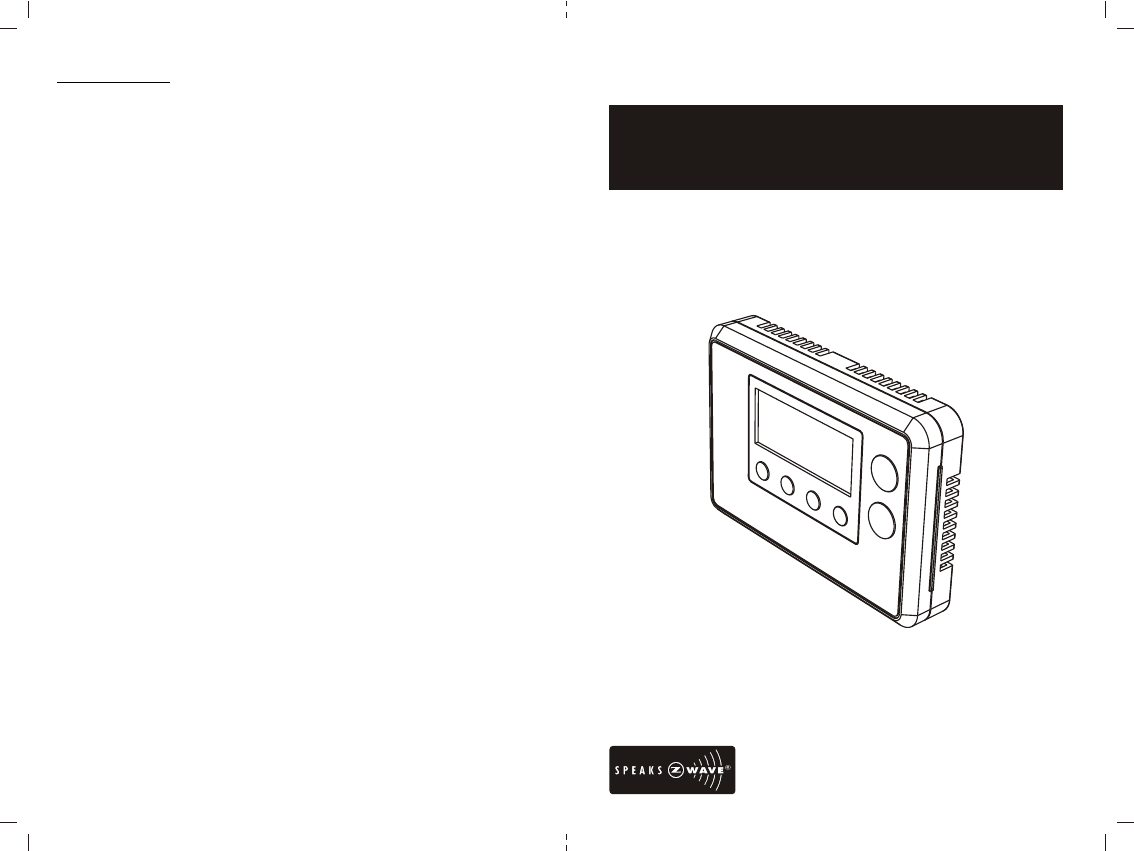
ZTS-110
Z-Thermostat
USER MANUAL
Printed in China F820-8031-0003
2/11/14
Firmware Version: 2.06
WARRANTY
ONE-YEAR LIMITED WARRANTY: Remotec warrants this product to be free from defects in
materials and workmanship under normal use and service for a period of one year from the
original date of purchase from the distributor or dealer.
REMOTEC shall not be liable for:
- Damages caused by defective devices for indirect, incidental, special, consequential or
punitive damages, including, inter alia, loss of profits, savings, data, loss of benefits, claims
by third parties and any property damage or personal injuries arising from or related to the
use of the device.
- Service trips to provide instruction on product use.
- Shipping costs for replacement products.
This warranty is limited to the repair or replacement of this product only, if the purchase date
cannot be substantiated, the warranty period will begin on the date of manufacture as indicated
on this product. All warranty claims must be made to Remotec appointed distributors or dealers
during the applicable warranty period. This warranty gives you specific legal right and you may
also have other rights which vary in each country.
www.remotec.com.hk
39
Revised on 2/13/14
Revised on 2/14/14
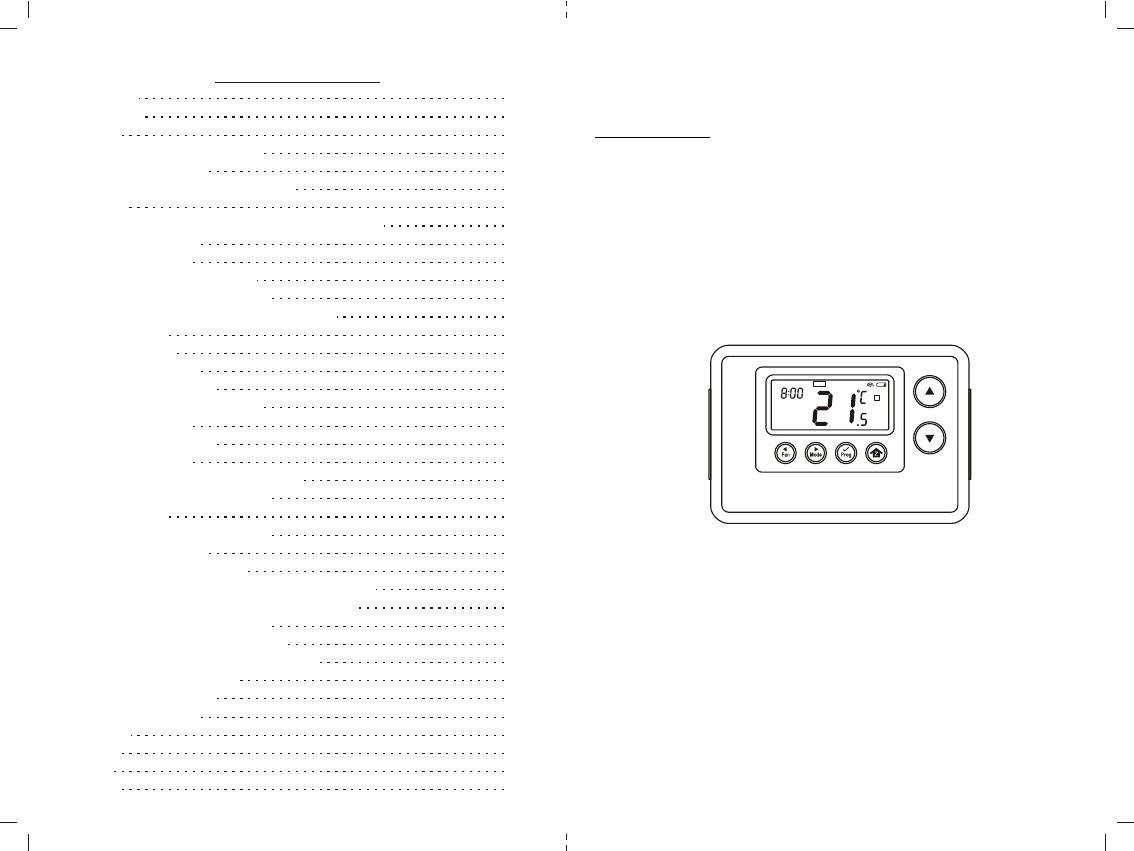
Table of Contents
Introduction 2
Features list 3
Glossary 4
Physical Installation and Wiring 5
Installation Location 6
6
Wiring 7
Jumper Settings for ELECTH-HPUMP and HE-HG 8
9
9
9
10
10
11
16
17
17
19
21
21
23
24
24
Check FLiRS / Always Listening mode in ZTS-110 26
27
29
35
36
37
38
38
Warranty 39
Physically Installing the Thermostat
Setup and Operations
Product Overview
Description of Function Keys
Activate/Deactivate Easy Mode
Temperature Scale selection in Easy Mode
Setting Mode
Change Mode
Change Fan Mode
Select Program Mode
Override/Permanent Override 18
Setting Schedule
Battery Low Indication
Defrost Indication
Out of Temperature Range Indication 22
Advanced Recovery Indication 22
Filter Counter 23
Short Cycle Start Up Protection
Energy Saving Mode
Z-Wave Setup and Operations
Z-Wave Add (Include) / Delete (Exclude) Mode
Support for Association Groups
Z-Wave Configuration Parameters 30
Reset ZTS-110 to Factory Default Settings 34
Frequently Asked Questions
Technical Specifications
Checking Accessories
FCC Notice 38
Warnings
Caution
ZTS-110 Z-Thermostat
Introduction
ZTS-110 Z-Thermostat (Figure 1) is a Z-Wave enabled programmable thermostat
that allows you to control your room temperature with programmable time schedule
such as WAKE, AWAY, HOME and SLEEP event which can maximize energy
conservation and comfort while minimizing the effort required to maintaining the
appropriate temperature in your home whether you are at home or away.
Also, you can use the ZTS-110 to control / check your room temperature by smart
phone or PC while you are at home or outside through Z-Wave gateway.
Figure 1. ZTS-110
1 2
WAKE
AM
PROG ON
MO
HEAT
FAN ON
1
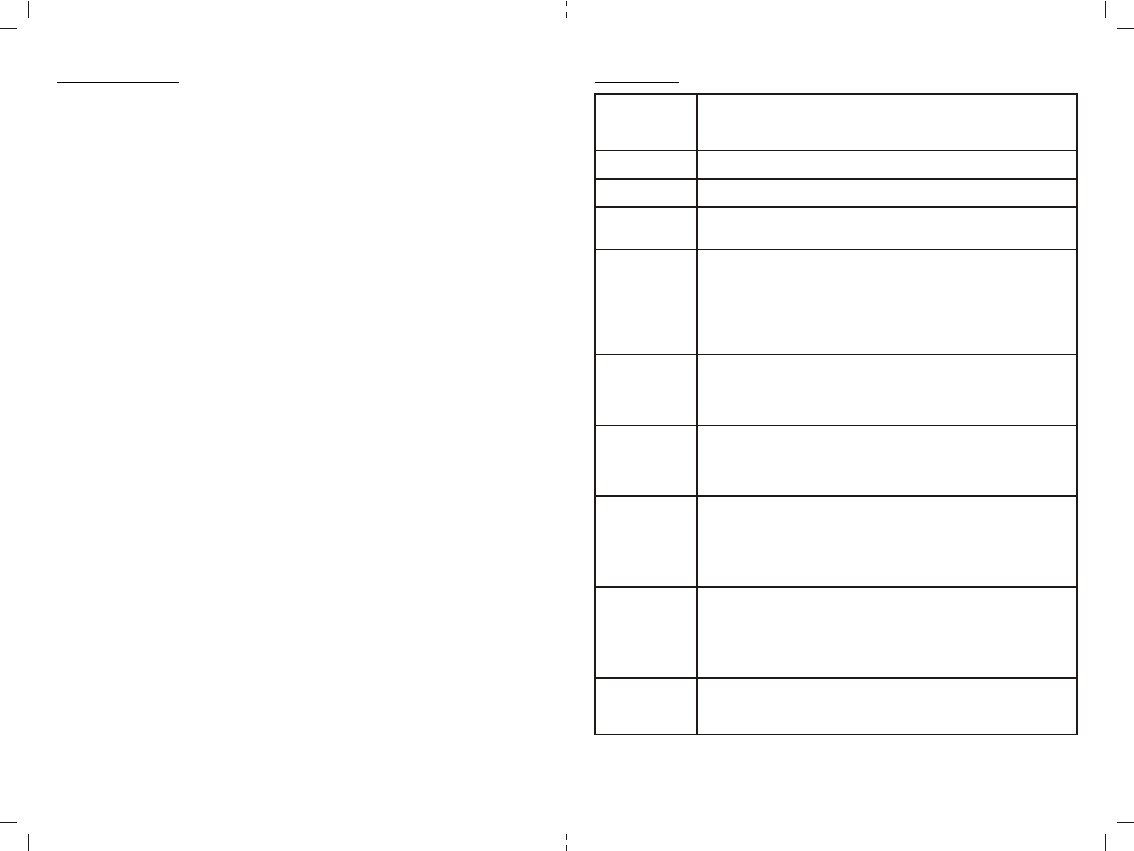
Features List
HVAC System Type Compatible:
- Standard (gas/electric) or Heat Pump
Multistage System Compatible:
- Standard HVAC Systems: 2 stage heating, 1 stage cooling
- Heat Pump Systems: 2 stage heating, 1 stage cooling
Heat Pump change over valve:
- Selectable change over with cool or with heat
Program Style:
- 2 program modes for scheduling (Mo-Fr, Sa-Su)
- 4 Separate Time and Temperature Settings for each program
- Heat and Cool set-points for each program
- Temporary Program Override
- Permanent Program Override
- Built-in flash memory stores heat and cool program settings
Temperature Display and Control:
o o
- Temperature display in F or C
o o
- Temperature Measurable Range: 32-99 F / 0-40 C
o o
- Temperature Setting Range: 41-99 F / 5-37 C
- Adjustable Temperature Control Swing/Differential
o o o o o o o o
a) Swing: 1 F, 2 F, 3 F or 4 F ( 0.5 C, 1.0 C, 1.5 C or 2 C)
o o o o o o o o
b) Differential: 1 F, 2 F, 3 F or 4 F ( 0.5 C, 1.0 C, 1.5 C or 2 C)
- Advanced Recovery Mode (ARM)
- Defrost Function
- Short cycle start up protection
Clock:
- Time display format: 12/24 hour clock selection with day displayed
Filter Counter:
- Filter change reminder displayed after 500 hours usage (500-4000hrs)
Z-Wave:
- Support Network Wide Inclusion (NWI) and Explore Frames
- Support Easy mode (disable local advanced setup and control)
- Support "Frequently Listening Routing Slaves" (FLiRS) mode and "Always Listening" mode
- Support battery level report
- Support Association Groups
a)Association Group_1 is used for Heat Pump control
b)Association Group_2 is used for Compressor control
c)Association Group_3 is used to report status change such as AUTO report to gateway
Power:
- Support AA x 4 alkaline batteries or 24Vac input
Glossary
Devices and nodes are all terms to describe an individual Z-Wave
device. These are all interchangeable when setting up your Z-Wave
network.
Device or Node
3 4
Inclusion Add a Z-Wave device to the network.
Exclusion Delete a Z-Wave device from the network.
Remove To take a device out of a group, scene or association group while that
device still exists in the same Z-Wave network.
Network Wide
Inclusion (NWI)
Network Wide Inclusion (NWI) enables both end-user friendly, Plug
and Play like Z-Wave network installation as well as professional
installation scenario where the inclusion process in terms of time will
be reduced significantly. NWI is a feature supported by a new frame
type named Explorer which enables the Z-Wave protocol to implement
Adaptive Source Routing.
Z-Wave
Network
A collection of Z-Wave devices is controlled by primary and secondary
controllers operating on the same system. A Z-Wave network has its
own unique ID code so that controllers not in the network cannot
control the system.
Primary
Controller
The first controller is used to set up your devices and network. Only
the Primary Controller can be used to include or delete devices from a
network. It is recommended that you mark the primary controller for
each network for ease in modifying your network.
FLiRS Mode
FLiRS is abbreviation for "Frequently Listening Routing Slave".
FLiRS mode is targeted for battery operated applications and will enter
sleep mode frequently in order to conserve battery consumption. The
response to Z-Wave command is not as quick as Always Listening
Device. Normally there is 1-2 seconds latency.
Always
Listening Mode
Always Listening mode is targeted for AC power operated applications
and it can act as a repeater, which will re-transmit the RF signal to
ensure that the signal is received by its intended destination by routing
the signal around obstacle and radio dead spots. The response to
Z-Wave command is immediate.
Association
Association is used to organize nodes in different groups allowing the
device to identify the nodes by a group identifier. The groups can also
be copied to other devices.
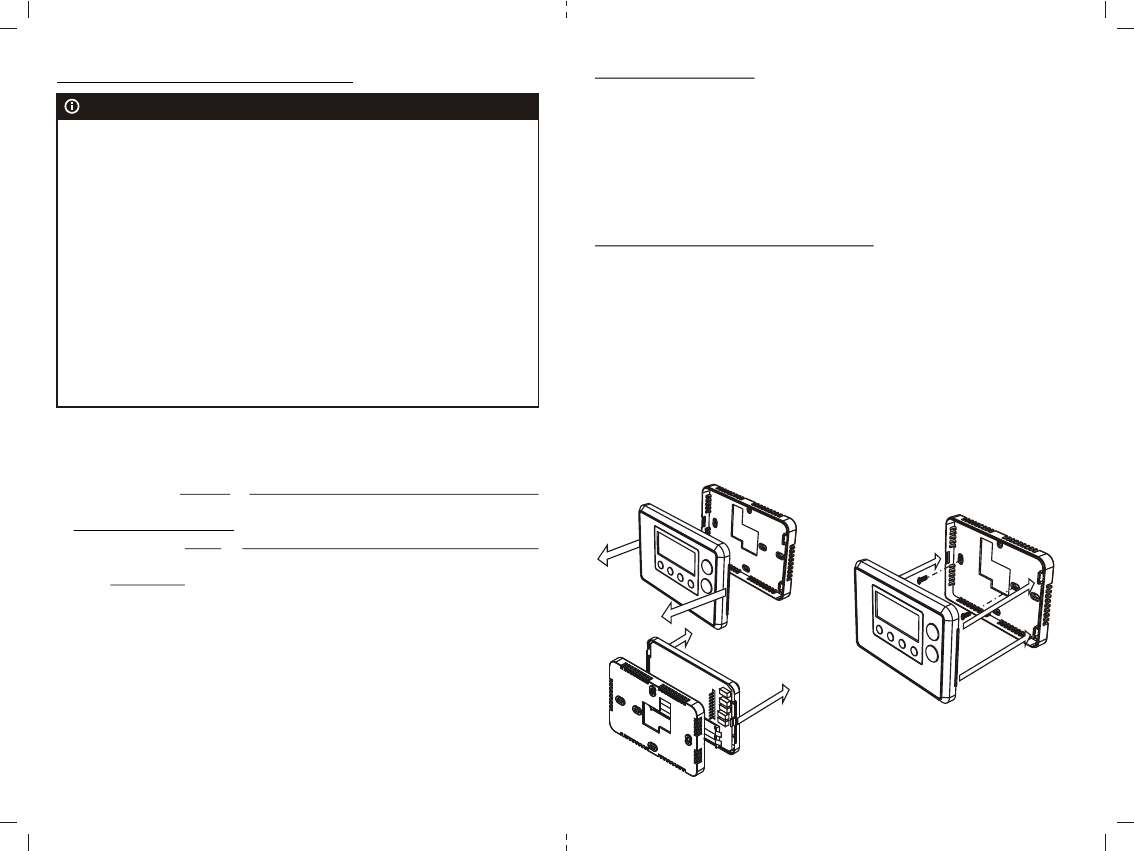
Physical Installation and Wiring
Read following scenarios carefully before you start as it matters to the
battery life under Z-Wave operation:
ZTS-110 can be powered by 4 x AA batteries, and/or 24Vac C wire.
a) If it is powered by batteries or powered by batteries first then applied with 24Vac
before Z-Wave inclusion, ZTS-110 will self-configure to FLiRS mode which will
save battery life by sleeping.
b) If it is powered by 24Vac or powered by 24Vac first then applied with batteries
before Z-Wave inclusion, ZTS-110 will self-configure to Always Listening Mode
which will not sleep.
c) After inclusion process, ZTS-110 will not detect power source and not allow
changing operation mode. You must perform exclusion process first if need to
change Z-Wave operation mode.
d) After Z-Wave inclusion process, if you reset ZTS-110 to default while both 24Vac
and batteries are applied, ZTS-110 will take 24Vac as primary power source and
self-configure to Always Listening Mode, because reset to default process will
automatically exclude ZTS-110 from the Z-Wave network. You should disconnect
the power source and re-apply the power so ZTS-110 can detect the power
source type and self-configure to corresponding mode.
You may check Glossary for the definition of FLiRS mode and Always Listening
Mode.
CAUTION
- We highly recommend that this installation procedure is performed by a
trained HVAC technician.
- Read the enclosed instructions carefully before installing your new Z-
Thermostat. Pay close attention to all warnings and notes and carefully
follow the installation steps in the order they are presented to save time and
minimize the risk of damaging the thermostat or the system it controls.
- Turn off ZTS-110 and the electronic devices (e.g. heater, cooler) which will
be connected and the electric source before installation and maintenance.
Battery safety!
- Use new batteries of the recommended type and size only.
- Never mix used and new batteries together.
- To avoid chemical leaks, remove batteries from the ZTS-110 if you do not
intend to use the unit for an extended period of time.
- Dispose of used batteries properly; do not burn or bury them.
5 6
Installation Location
The Thermostat is restricted to be used in indoor only. It should be mounted on an
inner wall about 1.5m (5ft) above the floor at a position where it is readily affected
by changes of the general room temperature with freely circulating air. Avoid
mounting above or near hot surfaces or equipment (e.g. TV, heater, refrigerator).
Avoid mounting where it will be exposed to direct sunshine, drafts, or in a laundry
room or other enclosed space. Do not expose this unit to dripping or splashing
liquids.
Physically Installing the Thermostat
1. Open the ZTS-110 by pulling the two sections apart (Figure 2). Use the fingertips
of one hand to grip the tab on the front housing.
2. Apply power to the thermostat:
a) For battery power, install four AA batteries (alkaline recommended). Match
the polarity of the batteries with the +/- marks inside the battery compartment.
b) For 24Vac power, connect the wires as described in "Wiring"
3. Insert the two included wall anchors into the wall, aligned with two of the
mounting holes in the back housing of the thermostat.
4. Fasten the back housing to the wall using the two included mounting screws.
Insert the screws through the mounting holes in the housing and into the wall
anchors. (Figure 3)
5. Align the front housing of the thermostat with the back housing and push until the
housing sections are locked together.
Figure 3. Install the front housing
Figure 2. Open ZTS-110
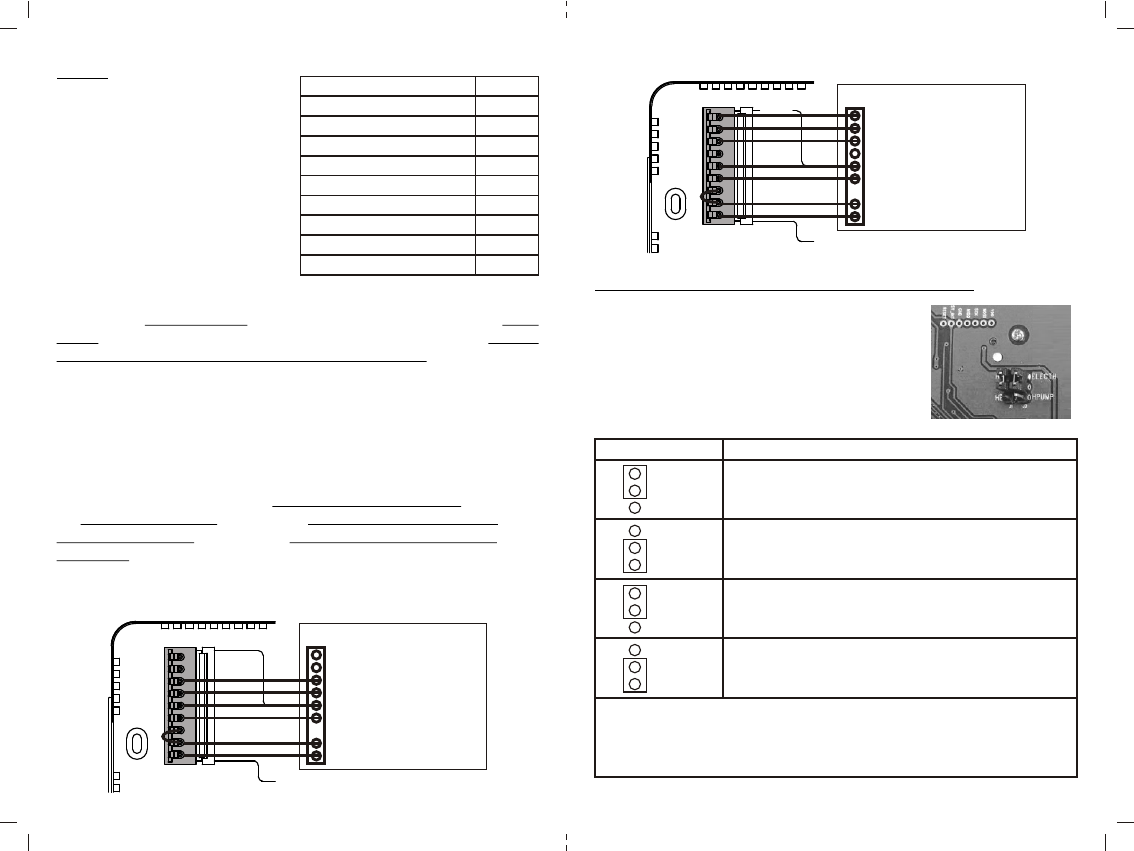
Figure 5. Heat pump system wiring
Jumper Settings for ELECTH-HPUMP and HE-HG
There are 6 jumpered pins on the thermostat circuit
board that identify whether your system is:
- Gas or electric heater
- Non-heat pump or heat pump system
You must ensure that these pins are set correctly for
your system. The pin location is shown in the following
diagram which is located at back side of ZTS-110.
7 8
Wiring
- Be sure the operation mode is OFF
and Fan selection is Fan Auto
- Wire the proper cables at the terminal
block according to the circuit diagram
- Afterward, push all cables back into
the wall
- Do not use metal conduit or of cable
provided with a metal sheath
- Recommends adding fuse or
protective device in the line circuit
Important!
If you will be powering the ZTS-110 with 24Vac:
Connect the "24Vac Common" (typically the black wire/terminal) and "24Vac
Power" (typically the Red wire/terminal) from the HVAC system to the ZTS-110
HVAC System terminal block "C" and "RH" or "RC" terminals (see the following
explanation, these may be jumpered together).
Common or Split Transformer Systems:
Most HVAC systems have a common heating and cooling transformer. You must
insert a jumper wire to tie the RH and RC inputs together for this configuration. If
you have a system with separate heating and cooling transformers, do not insert a
jumper wire between RC and RH.
When wiring split systems, wire the heating systems "24Vac Power" (red wire) to
the ZTS-110 "RH" terminal, and wire the cooling systems "24Vac Power" to the
ZTS-110 "RC" terminal. Also wire the cooling systems "24Vac Common" to the
ZTS-110 "C" terminals.
Note: Do not split RC/RH for Heat Pump systems!
Figure 4. Non-heat pump (Standard Gas or Electric) HVAC system wiring
Terminals
Cool changeover (heat pump)
Heat changeover (heat pump)
2nd Stage heater
1st Stage heater
Fan
Compressor
24Vac Common
24Vac Power for Cooling
24Vac Power for Heating
Symbol
O
B
W2
W1
G
Y
RC
RH
C
Standard HVAC System
nd
W2 - 2 stage heater
st
W1 - 1 stage heater
G - Fan
Y - Compressor
R - 24Vac Power
C - 24Vac Common
O
B
W2
W1
G
Y
RC
RH
C
Brown
White
Green
Yellow
Red
Black
Heat Pump HVAC System
O - Cool changeover (heat pump)
B - Heat changeover (heat pump)
nd
W2 - 2 stage heater
G - Fan
Y - Compressor
R - 24Vac Power
C - 24Vac Common
O
B
W2
W1
G
Y
RC
RH
C
Brown
Green
Yellow
Red
Black
Blue
Orange
Set to HG for Gas heat-fan controlled unit (Default)
Fan will maintain off state.
Set to HE for Electrical heat-fan controlled unit
Fan will be turned on when there is heating output.
HG
HE
HG
HE
Note:
The HE and HG jumper controls the Fan when set to Auto in heating mode.
If user selects Fan ON at thermostat, the Fan will be turned on without considering the
HE-HG jumper selection.
Jumper Function Description
Set to ELECTH for non-heat pump system (Default)
- When there is a heating request, thermostat will turn on W1
- When there is a cooling request, thermostat will turn on Y
Set to HPUMP for heat pump system
- When there is a heating request, thermostat will turn on Y and B
- When there is a cooling request, thermostat will turn on Y and O
ELECTH
HPUMP
ELECTH
HPUMP
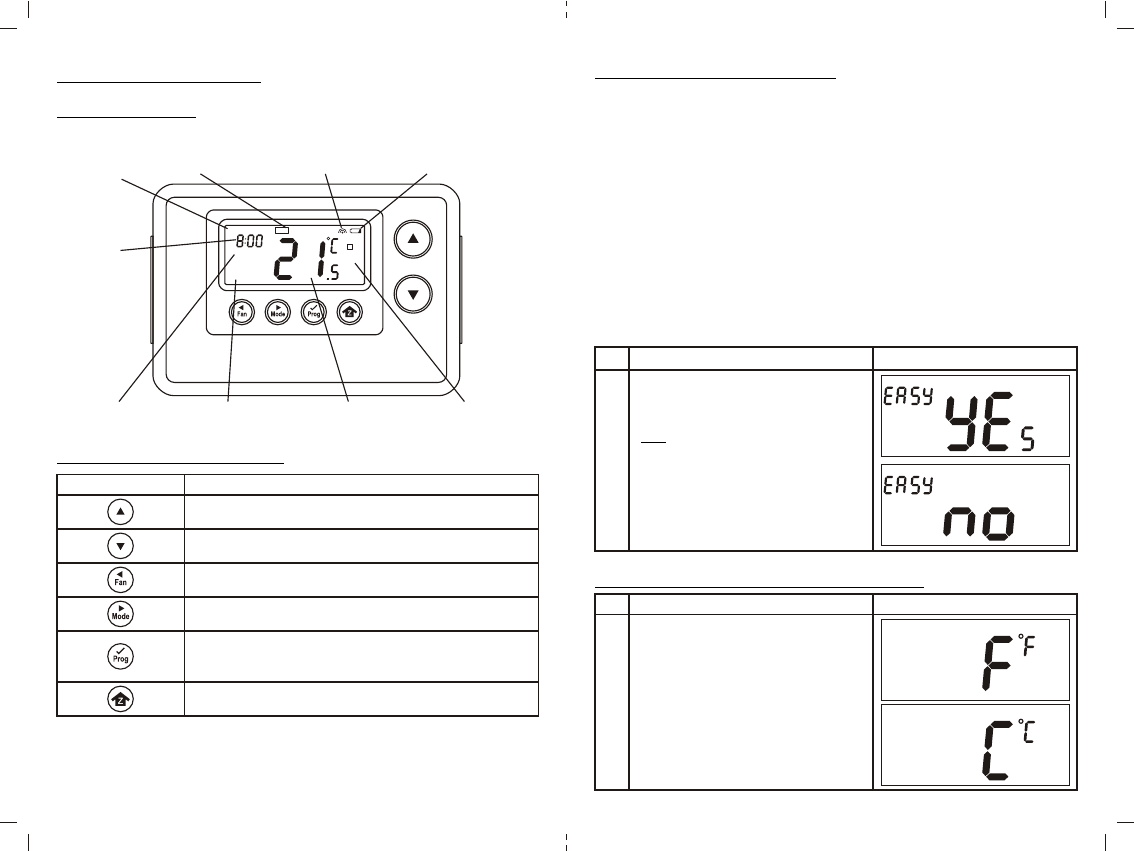
Activate/Deactivate Easy Mode
The ZTS-110 is default with Easy mode, below illustrates the functions of Easy
mode:
- Active functions: Change Mode, change Fan mode and Temperature Scale
selection
- Inactive functions: Scheduling, Program Mode, Clock Display, Setting Time,
Setting Swing, Setting, Differential Set-Point and Advanced
Recovery Mode
User can use Easy mode to disable Schedule function and the schedule will be
controlled by Z-Wave gateway. User can still change temperature and mode by
pressing the local physical buttons.
User can deactivate the Easy mode by local "Setting Mode" or Z-Wave
Configuration Parameter number 8. (Please refer to Z-Wave Configuration
parameters table).
Below is the example by local setting:
Temperature Scale selection in Easy Mode
9 10
Setup and Operations
Product Overview
Figure 6. ZTS-110
Description of Function Keys
Event mode
Day
Time
Program mode Fan mode
Inclusion indication Battery low indication
Mode
Current temperature
WAK E
AM
PROG ON
MO
HEAT
FAN ON
1
Key Description
Symbol
Increase value / Toggle selection
Decrease value / Toggle selection
Select fan mode; also the Backward function key in some menus
Change operation mode; also the Forward function key in some
menus
Select program mode:
PROG ON, OVERRIDE and PERMANENT OVERRIDE;
also the Confirm function key in some menus
Back to Home
LCD indicationStep Procedure / Description
Press and hold "Mode" key for 2 seconds to
entry the setting mode.
It will display "EASY YES" if it stays in
Easy mode. Otherwise, it will display "EASY
no" if Easy mode is deactivated.
Press Up/Down key to toggle the selection.
Press "Prog" key to confirm your settings.
- it will go back to Home page if selected
"YES".
- it will go to Day setting if selected "no".
1
Press and hold "Prog" keys for 2 seconds to
entry temperature F (Fahrenheit) -> C
(Celsius) selection mode.
Press Up/Down key to toggle the
temperature F (Fahrenheit) -> C (Celsius)
selection.
Press "Prog" key to confirm it and back to
the Home page.
1
LCD indicationStep Procedure / Description

11 12
Note:
If you deactivated the Easy mode, please refer to Setting Mode for the temperature
scale selection.
Setting Mode (Set Day, Clock, 12/24 hour, F/C, Swing and
Differential)
Setting Mode Key DescriptionSymbol
Increase value / Toggle selection
Decrease value / Toggle selection
Backward to previous setting
Forward to next setting
Confirm and go to next setting
Confirm and go back to Home
If you deactivated the Easy mode, you can continue to set up Day, Clock, 12/24
hour, F/C, Swing and Differential. Refer to below for steps:
LCD indicationStep Procedure / Description
Press and hold "Mode" key for 2 seconds
to entry the setting mode.
It will display "EASY YES" if it stays in
EASY mode. Otherwise, it will display
"EASY no" if EASY mode is deactivated.
Press Up/Down key to toggle the selection.
Press "Prog" key to confirm your settings.
- it will go back to Home page if selected
"YES".
- it will go to Day setting if selected "no".
EASY mode (default)
Local control active functions:
- Change Mode
- Change Fan mode
- Temperature Scale selection
Local control inactive functions:
- Scheduling
- Program Mode
- Clock Display
- Setting Time
- Setting Swing
- Setting Differential Set-Point
- Advanced Recovery Mode
EASY mode is deactivated
- Support full functions at local and Z-Wave
control
1
Day will keep flashing, press Up/Down key
to set day from MO-SU.
2
Press "Prog" key once to confirm the setting
and it will go to hour setting.
Hour will keep flashing, press Up/Down key
to set hour.
3
MO
AM
MO
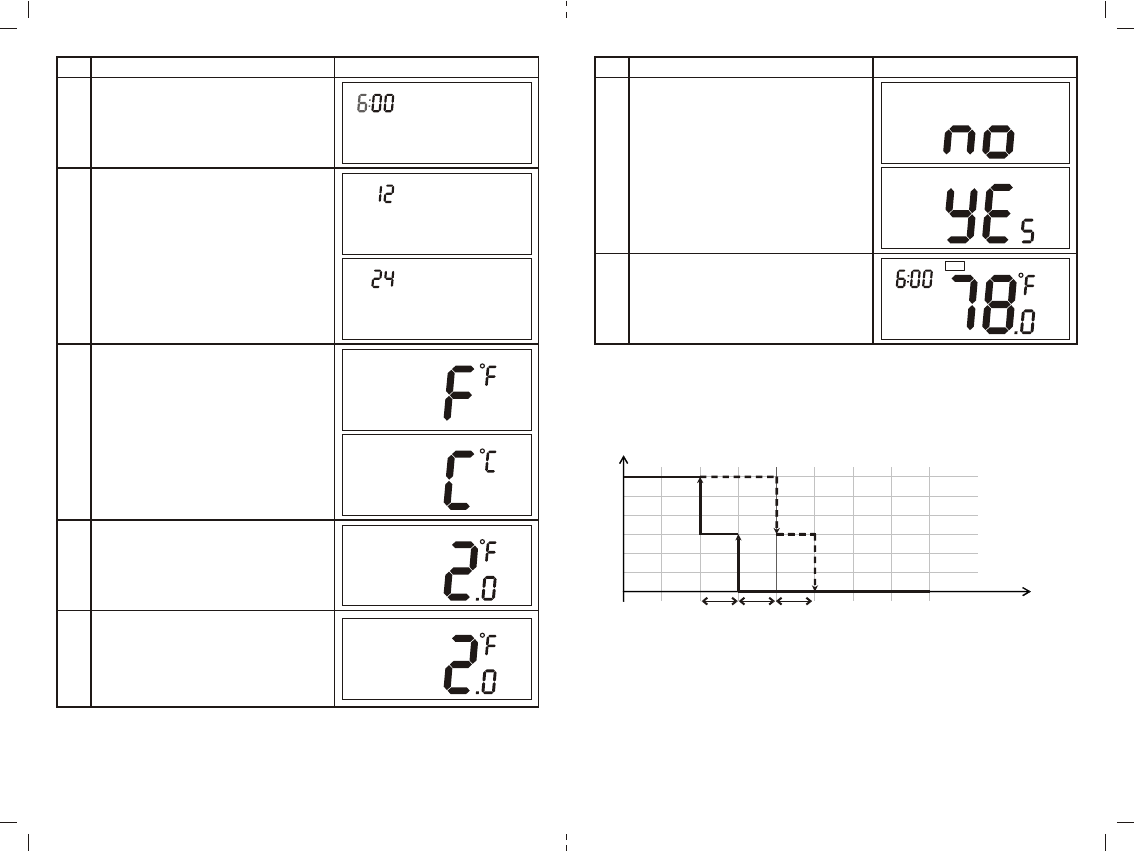
13
LCD indicationStep Procedure / Description
Press "Prog" key once to confirm the setting
and it will go to minutes setting.
Minutes will keep flashing, press Up/Down
key to set minutes.
4
Press "Prog" key once to confirm the setting
and it will go to 12/24 hour clock selection.
Press Up/Down key to toggle the 12/24
hour clock selection.
5
Press "Prog" key once to confirm the setting
and it will go to temperature F (Fahrenheit)
-> C (Celsius) selection.
Press Up/Down key to toggle the
temperature F (Fahrenheit) -> C (Celsius)
selection.
6
Press "Prog" key once to confirm the setting
and it will go to swing setting.
Press Up/Down key to set the swing setting.
oooo
(Range is from 0.5 C to 2 C or 1 F to 4 F )
7
AM
MO
AM
PM
HR
SWING
14
Note: Explanations of Swing and Differential set point
HEAT mode: thermostat controls the temperature according to the following
diagram
o o o
Example for Heating: (Set point = 70 F, Swing = 1 F, Differential = 2 F)
o o
=> 1st stage heater turns on when room temp is 69 F and off at 71 F.
o o
=> 2nd stage heater turns on when room temp is 67 F and off at 70 F.
LCD indicationStep Procedure / Description
Press "Prog" key once to confirm the setting
and it will go to differential set point setting.
Press Up/Down key to set the differential set
oo
point setting. (Range is from 0.5 C to 2 C or
oo
1 F to 4 F )
8
MO
DIFF
Press "Prog" key once to confirm the setting
and it will go to Advanced Recovery setting.
Press Up/Down key to enable/disable
Advanced Recovery Mode.
9
Press "Prog" key once to confirm the setting
and it will go to the Home page.
10
RECOVERY
RECOVERY
WAKE
AM
MO
FAN AUTO
PROG ON
OFF
Diff Swing SD= switch differential
Swing
Temperature
Output
Off
Heat
st
1 Turn off
nd
2 Turn off
Set point
st
1 Turn on
nd
2 Turn on
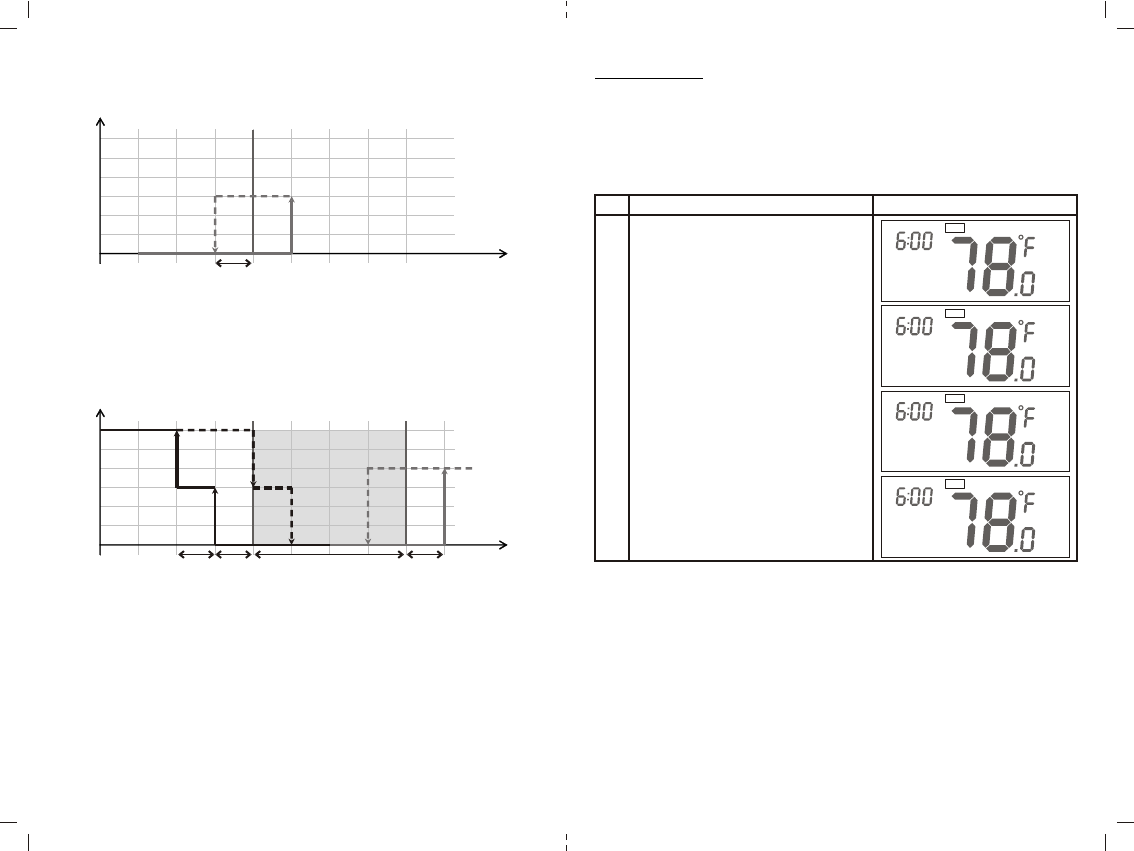
Change Mode
Note: In Heat mode =>it displays "HEAT" if ELECTH is selected during jumper
setting.
=> it displays "HEAT PUMP" if HPUMP is selected during
jumper setting.
Below example is based on HEAT PUMP
LCD indicationStep Procedure / Description
Press "Mode" key once to change the
operation mode:
OFF -> HEAT (PUMP) -> COOL -> AUTO
-> OFF
1
OFF
HEAT
COOL
AUTO
WAKE
AM
MO
FAN AUTO
WAKE
AM
MO
FAN AUTO
WAKE
AM
MO
FAN AUTO
WAKE
AM
MO
FAN AUTO
15 16
COOL Mode: thermostat controls the temperature according to the following
diagram
o o
Example for Cooling: (Set point = 80 F, Swing = 1 F)
o o
=> Cooler turns on when room temp is 81 F and off at 79 F.
AUTO: thermostat controls the temperature according to the following
diagram
o o
There is a dead band 4 F/2 C between heat set point and cool set point.
o
Example 1: If user select heat set point is 70 F, the minimum cool set point will be
o o
limited at "heat set point" + 4 F: 74 F
o o
Pervious heat set point is 70 F and cool set point is 74 F
o
Example 2: If user changes heat set point to 72 F, cool set point will be updated to
o
76 F automatically to maintain the dead band.
Swing
Temperature
Output
Off
Cool
Turn off
Set point
Turn on
Temperature
Output
Off
Heat
st
1 Turn off
nd
2 Turn off
Heat Set point
st
1 Turn on
nd
2 Turn on
Diff Swing SwingDead band
Cool Set point
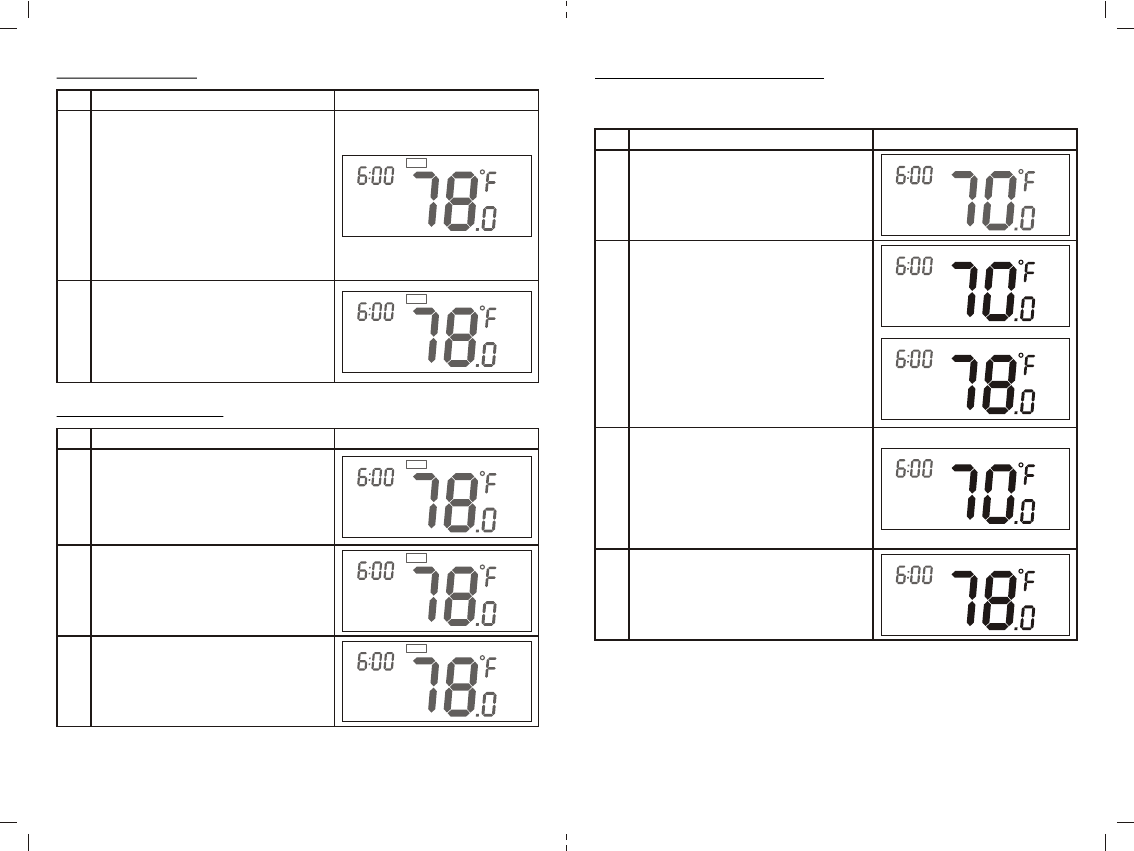
Override/Permanent Override
Note: Override/Permanent Override is only available in HEAT, COOL or AUTO
mode.
LCD indicationStep Procedure / Description
Press "Prog" key once to select PROG
mode: OVERRIDE or PERMANENT
OVERRIDE at Home page.
1
Press Up/Down key to adjust set point
temperature in HEAT or COOL mode.
Press "Prog" key once to confirm the setting.
2
In AUTO mode, user needs to set heat and
cool set points temperature.
Press Up/Down key to adjust auto heat set
points temperature in AUTO HEAT mode.
Press "Prog" key once to confirm the setting.
3
AM
MO
FAN AUTO
TARGET
HEAT
OVERRIDE
AM
MO
FAN AUTO
TARGET
HEAT
OVERRIDE
AM
MO
FAN AUTO
TARGETOVERRIDE
COOL
or
AM
MO
FAN AUTO
TARGET
HEAT
OVERRIDE
AUTO
Press Up/Down key to adjust auto cool set
point temperature in AUTO COOL mode.
Press "Prog" key once to confirm the setting
and go back to Home page.
4
AM
MO
FAN AUTO
TARGETOVERRIDE
AUTO
COOL
Change Fan Mode
Select Program Mode
LCD indicationStep Procedure / Description
Press "Prog" key once to select PROG
mode:
PROG ON -> OVERRIDE ->
PERMANENT OVERRIDE
PROG ON: Run the schedule.
1
LCD indicationStep Procedure / Description
Press "Fan" key once to change the Fan
mode:
FAN AUTO -> FAN ON
FAN AUTO:
Electric heat (HE):
Fan runs only when Heating/Cooling is
running.
Gas heat (HG):
Fan runs only when Cooling is running.
1
WAKE
AM
MO
FAN AUTO
COOL
Press "Fan" key once to change the Fan
mode:
FAN AUTO -> FAN ON
FAN ON:
Fan stays on all the time.
2
WAKE
AM
MO
FAN ON
COOL
WAKE
AM
MO
FAN AUTO
COOL
PROG ON
Press "Prog" key once to select PROG
mode:
OVERRIDE: Temporary override the current
schedule and will go back to "PROG ON"
when next time schedule reach.
2
WAKE
AM
MO
FAN AUTO
HEAT
OVERRIDE
Press "Prog" key once to select PROG
mode:
PERMANENT OVERRIDE:
Permanent override the schedule until user
change back to "PROG ON".
3
WAKE
AM
MO
FAN AUTO
HEAT
OVERRIDE
PERMANENT
17 18
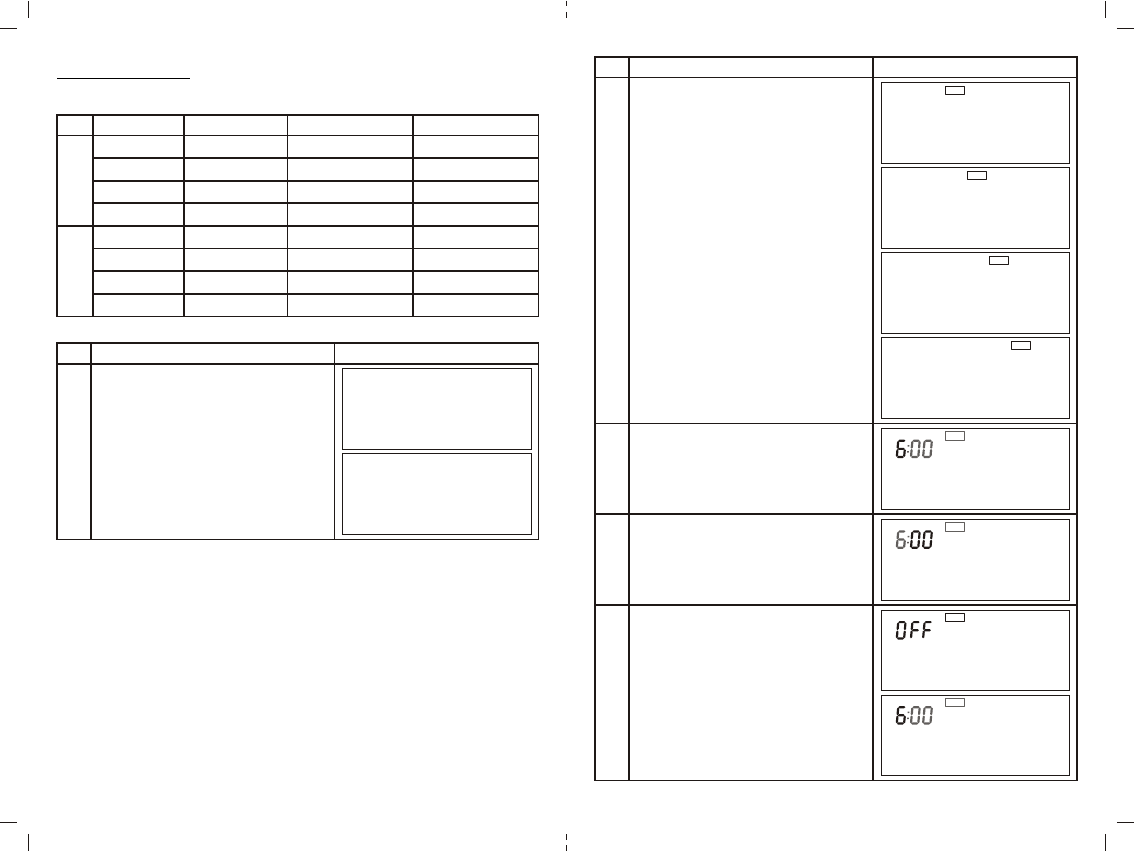
LCD indicationStep Procedure / Description
Press "Prog" key once to confirm the setting
and it will go to event mode.
Press Up/Down key to select the event
(WAKE -> AWAY -> HOME -> SLEEP).
2
Press "Prog" key once to confirm the setting
and it will go to hour setting.
Hour will keep flashing, press Up/Down key
to set hour.
3
Press "Prog" key once to confirm the setting
and it will go to minutes setting.
Minutes will keep flashing, press Up/Down
key to set minutes.
4
Press and hold "UP" and "DOWN" key for
2 seconds to disable / enable event during
the time setting.
If the event is disabled, "OFF" will be
displayed.
If the event is enabled, time will be displayed
and Hour will keep flashing.
5
WAKE
MO TU WE TH FR
AWAY
HOME
SLEEP
MO
MO
MO
TU
TU
TU
WE
WE
WE
TH
TH
TH
FR
FR
FR
WAKE
AM
MO TU WE TH FR
WAKE
AM
MO TU WE TH FR
WAKE
MO TU WE TH FR
WAKE
AM
MO TU WE TH FR
Setting Schedule
Pre-defined Schedule (disabled by default):
LCD indicationStep Procedure / Description
Press and hold "Prog" key for 2 seconds to
entry the setting schedule mode.
Press Up/Down key to select MO-FR or
SA-SU schedule.
1
TimeEvent
MO
I
FR
Heat Cool
WAKE
AWAY
HOME
SLEEP
6:00AM
8:00AM
6:00PM
10:00PM
oo
70 F (21 C)
oo
62 F (17 C)
oo
70 F (21 C)
oo
62 F (17 C)
oo
78 F (26 C)
oo
85 F (29 C)
oo
78 F (26 C)
oo
82 F (28 C)
SA
I
SU
WAKE
AWAY
HOME
SLEEP
6:00AM
10:00AM
6:00PM
11:00PM
oo
70 F (21 C)
oo
62 F (17 C)
oo
70 F (21 C)
oo
62 F (17 C)
oo
78 F (26 C)
oo
85 F (29 C)
oo
78 F (26 C)
oo
82 F (28 C)
MO TU WE TH FR
SA SU
19 20
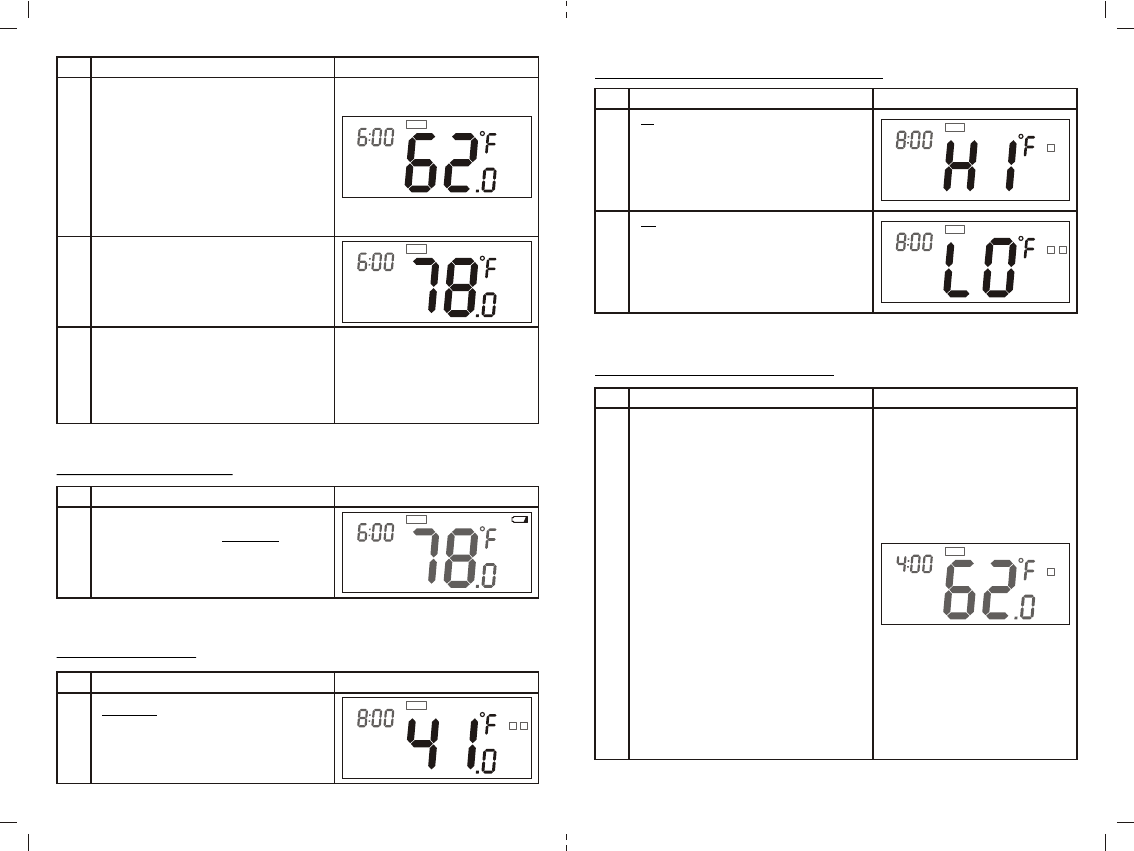
LCD indicationStep Procedure / Description
HI icon will be displayed on LCD if
temperature excess the measurement
o o
ranges 99 F/40 C.
All heaters will be forced Off.
Cooler will turn on if running cool mode.
1
WAKE
AM
TU
FAN AUTO
1
COOL
WAKE
DEFROST
AM
TU
HEAT
FAN AUTO
12
PUMP
LO icon will be displayed on LCD if
temperature below the measurement ranges
o o
32 F/0 C.
All heaters will be forced On, except in cool
mode.
2
Battery Low Indication
Defrost Indication
LCD indicationStep Procedure / Description
Press "Prog" key once to confirm the setting
and it will go to target setting.
If the event is enabled, it will go to target
setting.
Target will keep flashing, press Up/Down
key to adjust Heat set point for heating.
If the event is disabled, it will go to next
event setting.
6
WAKE
TARGET
AM
MO TU WE TH FR
HEAT
Press "Prog" key once to confirm the
setting and it will go to target setting.
Target will keep flashing, press Up/Down
key to adjust Cool set point for cooling.
7
WAKE
TARGET
AM
MO TU WE TH FR
COOL
Press "Prog" key once to confirm the setting
and it will go to next event mode.
Follow the program UI to complete the
whole scheduling or press Home key once
to save and exit.
8
21 22
LCD indicationStep Procedure / Description
ZTS-110 thermostat will detect the battery
level every 30 minutes; Battery low icon will
be displayed at Home page if the battery is
running out. (User is required to change
new batteries.)
1
WAKE
AM
PROG ON
MO
HEAT
PUMP
LCD indicationStep Procedure / Description
DEFROST icon will be displayed at Home
oo
page if temperature below 41 F/5 C.
All heaters will be forced On, except in cool
mode.
1
WAKE
DEFROST
AM
TU
HEAT
FAN AUTO
12
PUMP
Out of Temperature Range Indication
Advanced Recovery Indication
LCD indicationStep Procedure / Description
The Advanced Recovery feature allows
heating and cooling systems to gradually
recover from an energy-saving set point
temperature to a comfort set point
temperature. Advanced Recovery calculates
the time needed to adjust the temperature to
the next program setting. When the
thermostat is in Advanced Recovery mode,
the display will show "RECOVERY".
Advanced Recovery is an option that allows
the HVAC system to attempt to recover from
a setback period and reach a desired
comfort temperature set point by the
beginning of your programmed comfort
period. This option allows the choice
whether to use Advanced Recovery under
Setting Mode.
(Recovery works in heat, cool and auto
mode. Maximum Advanced Recovery time
is one hour.)
1
WAKE
AM
MO
HEAT
FAN AUTO
1
RECOVERY
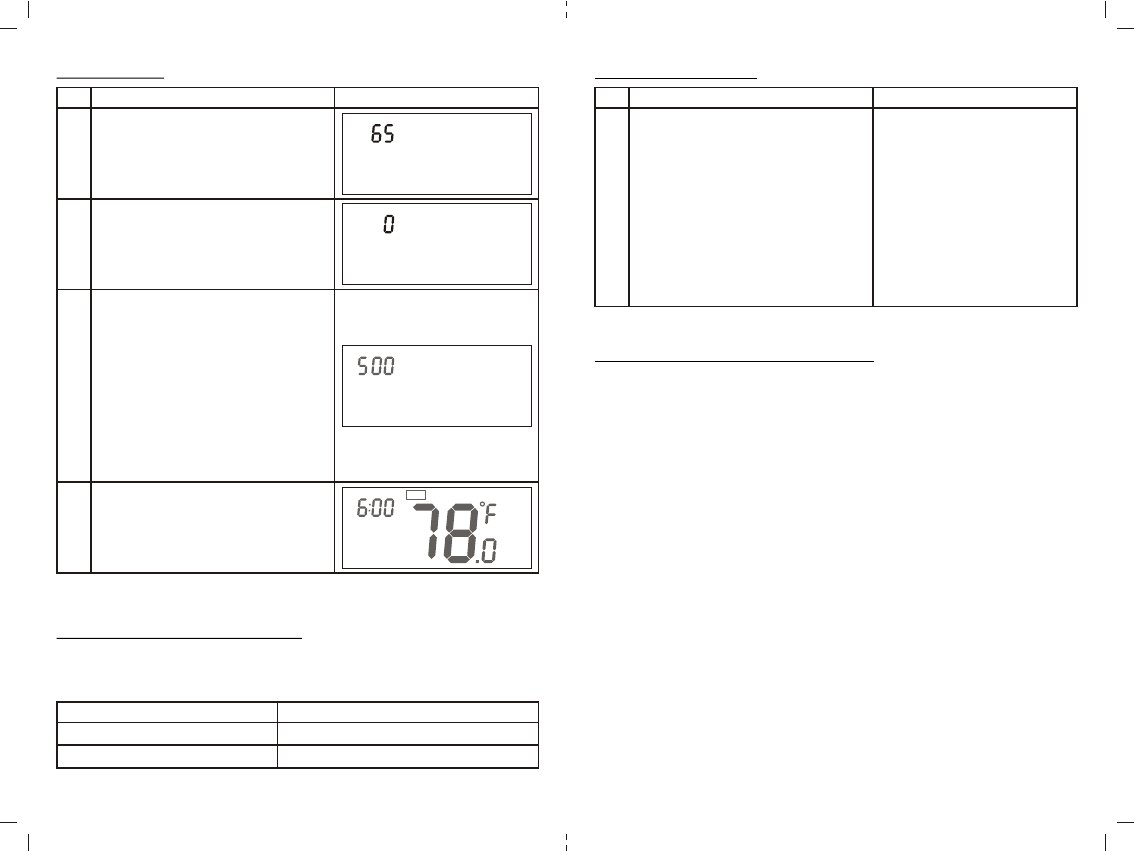
23 24
Filter Counter
Short Cycle Start Up Protection
To protect the compressor / Heat pump, those outputs forced off until 3minutes
count down finished. Those outputs can be activated according to the room
temperature after 3 minutes.
Press and hold "Mode" key to set the alert
time for the filter usage. "Target" icon will be
shown on screen and flashing.
Press "UP" or "Down" to set the alert time.
(Range from 500 to 4000 Hours Step size
is 100hrs)
Press "Prog" key to confirm the setting and
go back to filter counter page.
Press "Home" key once to go back to the
Home page.
3
TARGET
FILTER
HR
FILTER icon will be shown on the screen at
Home page when the usage hours were
reached to set time.
4
WAKE
FILTER
AM
PROG ON
MO
COOL
FAN AUTO
System Output
Non Heat pump system
Heat pump system
Compressor
1st stage heat and compressor
Energy Saving Mode
Z-Wave Setup and Operations
Setting FLiRS or Always Listening mode
- Setting to Z-Wave FLiRS mode with batteries as power source
ZTS-110 will self-configure to FLiRS mode if it is powered by batteries or
powered by batteries first then applied with 24Vac before Z-Wave inclusion.
FLiRS mode is targeted for battery operated applications and will enter sleep
mode frequently in order to save battery life. ZTS-110 can't act as a repeater in
this mode. The response to Z-Wave command is not as quick as Always
Listening Device. Normally there is 1-2 seconds latency on response, you
should avoid sending commands to ZTS-110 too frequently.
- Setting to Z-Wave Always Listening mode with 24Vac as power source
ZTS-110 will self-configure to Always Listening Mode if it is powered by 24Vac or
powered by 24Vac first then applied with batteries before Z-Wave inclusion.
Always Listening mode is targeted for AC power operated applications and it can
act as a repeater which will re-transmit the RF signal to ensure that the signal is
received by its intended destination by routing the signal around obstacle and
radio dead spots. The response to Z-Wave command is immediate.
LCD indication
Step Procedure / Description
Press and hold "Fan" key for 2 seconds to
check the filter counter.
The "usage hours" will be shown on screen.
1
Press and hold "Prog" key for 2 seconds to
reset the filter counter after replace a new
filter.
2
FILTER
HR
FILTER
HR
LCD indicationStep Procedure / Description
User can enable/disable energy saving
mode by using Z-Wave BASIC set command
only. (you may refer to the Z-Wave primary
controller UI for it)
=> Enable energy saving mode
Basic set value = 0x00 (off)
(energy saving mode will be mapped to off
mode)
=> Disable energy saving mode
Basic set value = 0xFF (Resume)
(comfort mode will mapped to resume mode)
1
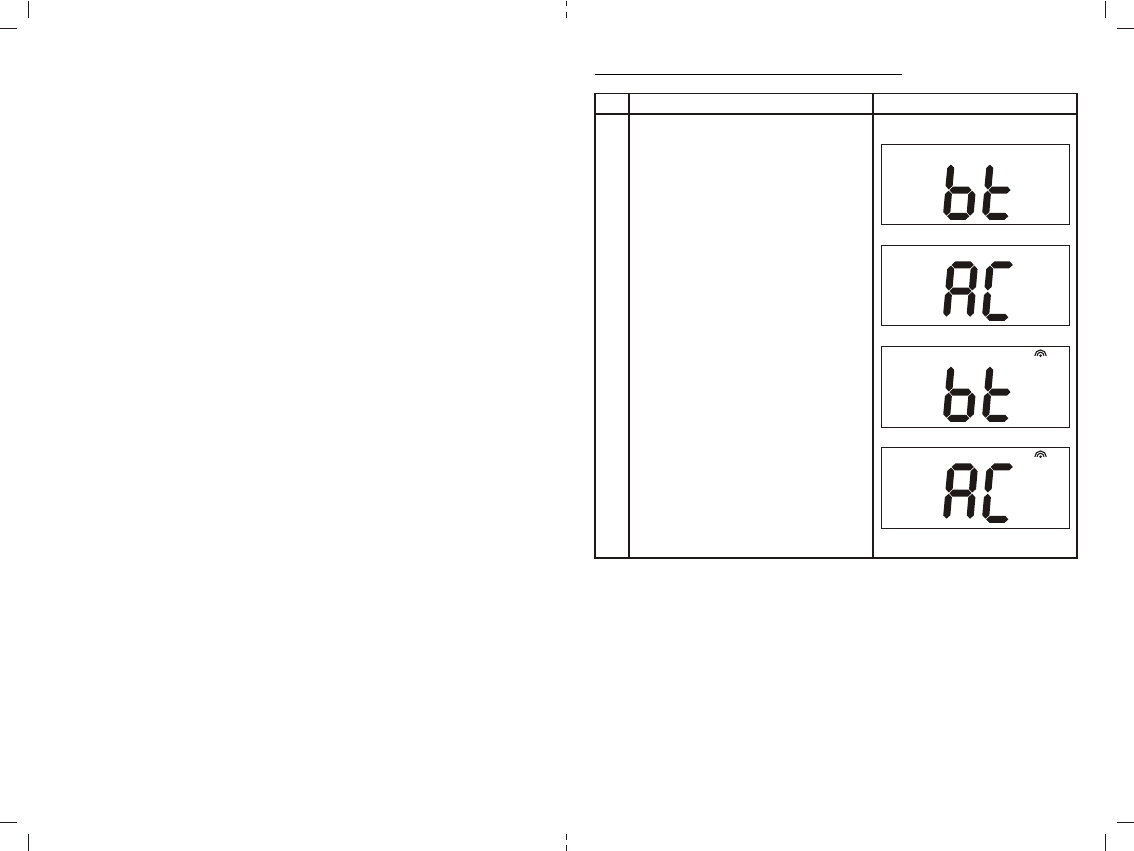
Check FLiRS / Always Listening mode in ZTS-110
Note:
After Z-Wave inclusion process, if you reset ZTS-110 to default while both 24Vac
and batteries are applied, ZTS-110 will take 24Vac as primary power source and
self-configure to Always Listening Mode. If you are using battery as back up, and
the AC power is down, the battery will drain very fast, battery will only survive 3-5
days.
LCD indicationStep Procedure / Description
During normal operation, press and
keep holding the keys on "Fan" +
"Mode" + "Prog" for 3 seconds.
(The unit will resume to normal
operation after released all keys.)
- If the LCD displays "bt", the unit is
detected to be FLiRS mode if it will
be included into Z-Wave network;
- If the LCD displays "AC", the unit is
detected to be Always Listening
mode if it will be included into Z-
Wave network;
- If the LCD displays "bt" + "RF icon",
the unit is in FLiRS mode and is
included into Z-Wave network;
- If the LCD displays "AC" + "RF
icon", the unit is in Always Listening
mode and is included into Z-Wave
network.
1
25 26
Important:
Please note the below scenarios for power applying because it will affect the battery
life if the steps are not correct (this is also mentioned at Physical Installation and
Wiring section in this user manual):
a) If it is powered by batteries or powered by batteries first then applied with
24Vac before Z-Wave inclusion, ZTS-110 will self-configure to FLiRS mode
which will save battery life by sleeping.
b) If it is powered by 24Vac or powered by 24Vac first then applied with batteries
before Z-Wave inclusion, ZTS-110 will self-configure to Always Listening Mode
which will not sleep.
c) After inclusion process, ZTS-110 will not detect power source and not allow
changing operation mode. You must perform exclusion process first if need to
change Z-Wave operation mode.
d) After Z-Wave inclusion process, if you reset ZTS-110 to default while both
24Vac and batteries are applied, ZTS-110 will take 24Vac as primary power
source and self-configure to Always Listening Mode, because reset to default
process will automatically exclude ZTS-110 from the Z-Wave network. You
should disconnect the power source and re-apply the power so ZTS-110 can
detect the power source type and self-configure to corresponding mode.
Remark:
- If you are using battery and somehow it is in Z-Wave Always Listening Mode, or
if you are using battery as back up, and the AC power is down, the battery will
drain very fast (battery will only survive 3-5 days).
- Regardless the FLiRS mode or Always Listening Mode, the setup and
operations are same, and you can also use local control while is it included to Z-
Wave network.
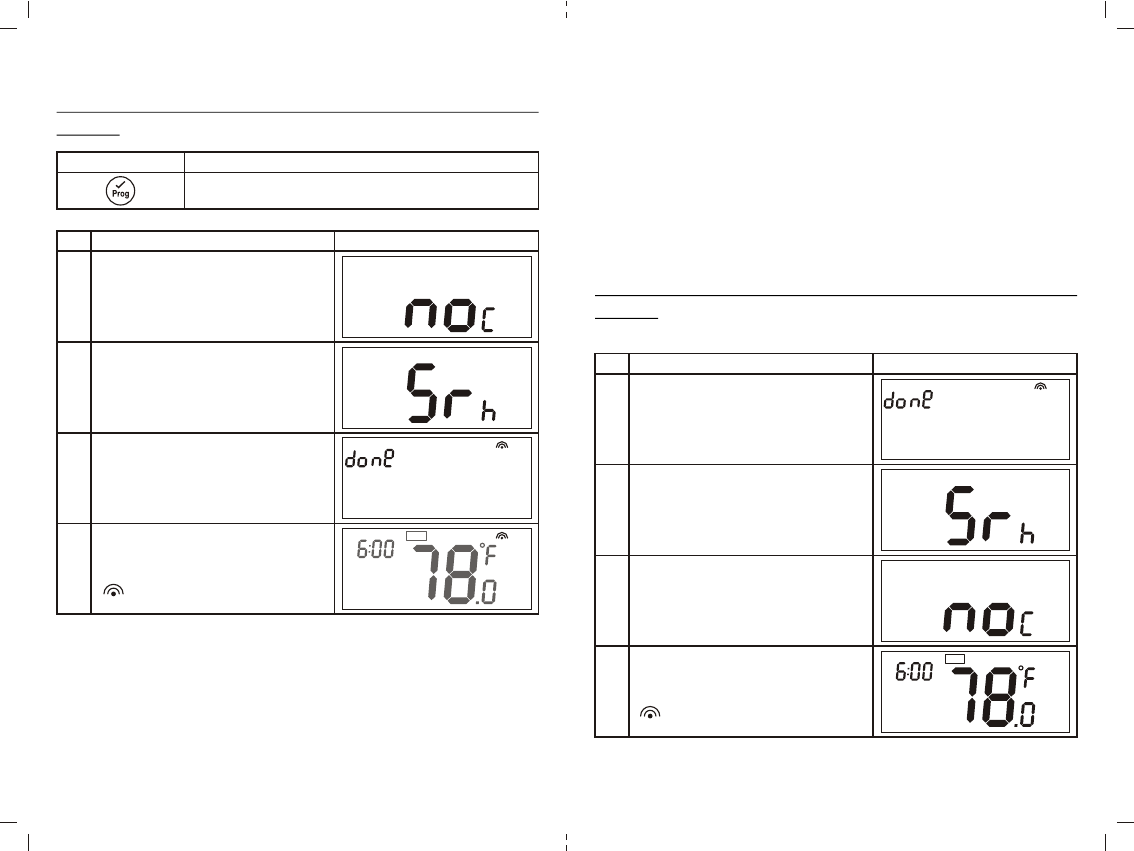
Z-Wave Add (Include) / Delete (Exclude) into/from Z-Wave network
Add (Include) ZTS-110 to Gateway / Controller Z-Wave
network
27 28
LCD indicationStep Procedure / Description
Gateway / Controller device should be set to
Exclusion mode.
Press and hold "Home" key for 2 seconds
to set ZTS-110 to Add (Inclusion) / Delete
(Exclusion) Mode.
1
Press "Prog" key once, it will search the
network.
2
If the ZTS-110 is removed from the network,
it shows no connection. Exclusion is
completed.
3
Press "Home" key once to go back to the
home page.
will appear on the main display.
4
WAKE
AM
PROG ON
MO
FAN AUTO
OFF
Inclusion and Exclusion Mode Key DescriptionSymbol
Add (Include) / Delete (Exclude)
LCD indicationStep Procedure / Description
Gateway / Controller device should be set
to inclusion mode.
Press and hold "Home" key for 2 seconds
to set ZTS-110 to Add (Inclusion) / Delete
(Exclusion) Mode.
1
Press "Prog" key once, it will search the
network.
2
If the ZTS-110 is added into the network
successfully, the signal of "done" will
appear.
3
Press "Home" key once to go back to the
home page.
will appear on the main display.
4
WAKE
AM
PROG ON
MO
COOL
FAN AUTO
Note:
- It is recommended to perform the Delete/Exclude procedure before doing
Add/Include. This is to make sure the ZTS-110 is not in any other Z-Wave
network which will result in failure in Inclusion process.
- If the inclusion is failed, try exclusion, and/or reset ZTS-110 to factory default and
try inclusion again.
- After ZTS-110 is included to Z-Wave network, it will stay in Easy mode by default.
- You can enable or disable Easy mode by local "Setting Mode" or Z-Wave
parameter number 8.
(please refer to parameter table at Z-Wave Configuration Parameters).
Delete (Exclude) ZTS-110 from Gateway / Controller Z-Wave
network

29 30
Association Groups setting example (case 3):
Z-Wave Configuration Parameters
Different user has different preferred settings of their thermostat, you may use the
below configuration parameters to change settings of corresponding functionality.
500 (0x01F4) to 4000 (0x0FA0) hours
Default = 500 (0x01F4) hours
Resolution = 100 (0x0064) hours
3 (0x03)
Set filter counter
F-BW8041 (ZFM-80)
(Node ID-A)
F-BW8041 (ZFM-80)
(Node ID-B)
F-BW8041 (ZFM-80)
(Node ID-C)
F-BW8041 (ZFM-80)
(Node ID-D)
Z-Wave Gateway
(Node ID-E)
Association group_1
for Heat Pump
Association group_2
for Compressor
Association group_3
for Auto report to
gateway
F-BW8031 (ZTS-110)
Parameter value rangeParameter No.
o o
1 (0x01) = 1 F / 0.5 C
o o
2 (0x02) = 2 F / 1.0 C (default)
o o
3 (0x03) = 3 F / 1.5 C
o o
4 (0x04) = 4 F / 2.0 C
1 (0x01)
o o
1 (0x01) = 1 F / 0.5 C
o o
2 (0x02) = 2 F / 1.0 C (default)
o o
3 (0x03) = 3 F / 1.5 C
o o
4 (0x04) = 4 F / 2.0 C
2 (0x02)
Functions
Swing
Differential
Support Association Groups (Association Command Class)
ZTS-110 supports 3 association groups.
Association group_3: (Auto report)
- Association group_3 is used to report status change to gateway. (Only gateway
or controller can be assigned in this association group)
ZTS-110 will trigger AUTO report function if one of below status is changed.
I. Operation mode (Off, Heat, Cool, Auto)
II. Operation state (Heat on or off, Cool on or off)
III. Fan mode (Auto, Auto low)
IV. Fan state (Fan on or Fan off)
o
V. Heat set point (report in precision 1 after decimal, e.g. 21.1 C )
o
VI. Cool set point (report in precision 1 after decimal, e.g. 23.3 C )
o
VII. Current room temperature (report in precision 1 after decimal, e.g. 24.0 C)
o o
(It will trigger room temperature report if there is 4 F or 2 C (default) differ from
last report. You can change this setting by set the configuration parameter)
Note: Total 5 devices (nodes) can be assigned in total 3 association groups. Below
table lists out the devices (nodes) allocations in the 3 association groups.
Important: Please do not associate heat pump and compressor devices in same
association group because heat pump and compressor device cannot be turned on
simultaneously!
Case No. No. of Node ID in
Association group_1
No. of Node ID in
Association group_2
No. of Node ID in
Association group_3
Case 1 4 01 (AUTO report)
Case 2 311 (AUTO report)
Case 3 2 2 1 (AUTO report)
Case 4 131 (AUTO report)
Case 5 041 (AUTO report)
Association group Association group_1
(Heat pump)
Association group_2
(Compressor)
Mode
Heating mode ON
(basic set command 0xFF)
OFF
(basic set command 0x00)
Cooling mode
OFF
OFF
(basic set command 0x00)
OFF
(basic set command 0x00)
ON
(basic set command 0xFF)
OFF
(basic set command 0x00)
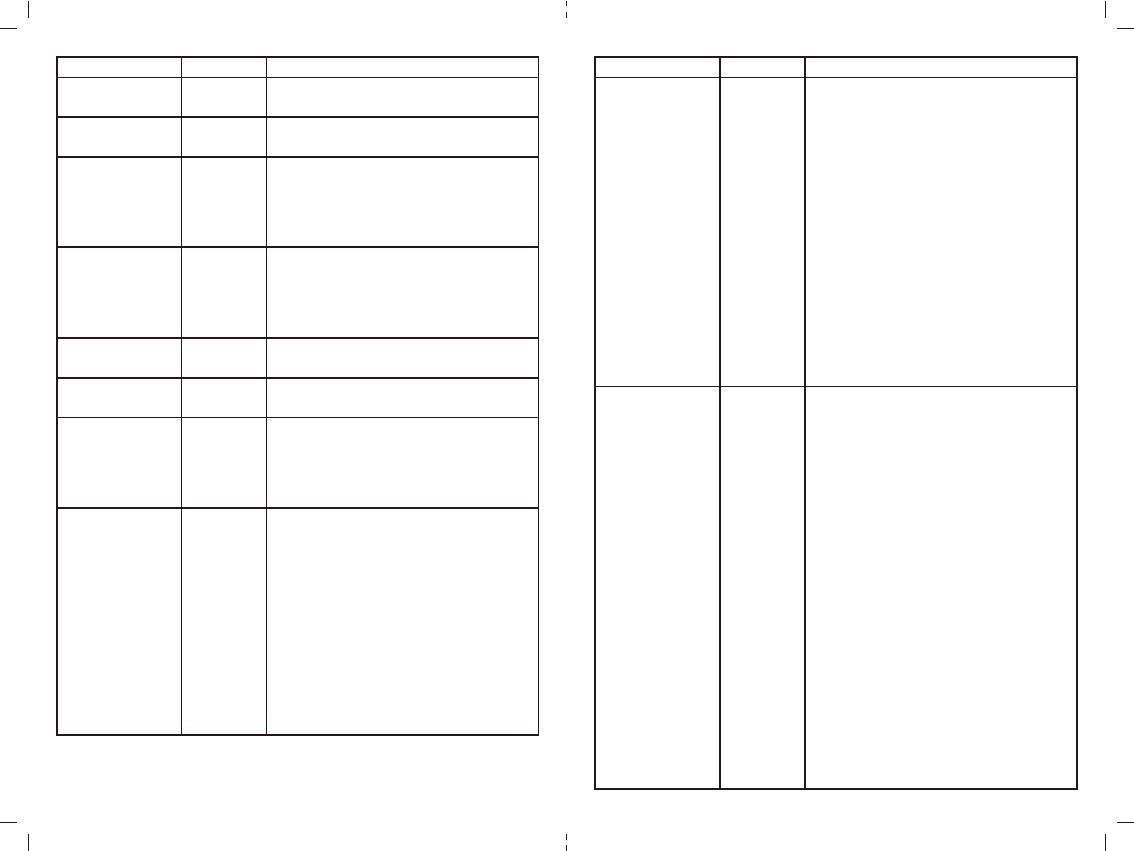
Parameter value rangeParameter No.
Functions
0 (0x0000) to 9999 (0x270F) hours
4 (0x04)
(A) available range:
o
Unit in Celsius ( C):
o
A = (B+2)min. ~ (37.0 C) max.
o
Unit in Fahrenheit ( F):
o o
A = (B+4)min. ~ (99.0 F) max. (default = 99.0 F)
6 (0x06)
o
0 (0x00) = C
o
1 (0x01) = F (default)
5 (0x05)
(B) available range:
o
Unit in Celsius ( C):
o o
5.0 C to 35.0 C
o
Unit in Fahrenheit ( F):
o o o
41.0 F to 95.0 F (default = 41.0 F)
7 (0x07)
0 (0x00) = Disable
1 (0x01) = Enable, default
8 (0x08)
Report filter counter
(read only)
Upper limit of set
point (A)
Scale of temperature
Lower limit of set
point (B)
Easy mode
0 (0x00) = disable AUTO report if room
temperature is different from last report.
AUTO report if room temperature is different from
last report.
Delta change is >=
o o
1 (0x01) = 1 F (0.5 C)
o o
2 (0x02) = 2 F (1.0 C)
o o
3 (0x03) = 3 F (1.5 C)
o o
4 (0x04) = 4 F (2.0 C), (default)
o o
5 (0x05) = 5 F (2.5 C)
o o
6 (0x06) = 6 F (3.0 C)
o o
7 (0x07) = 7 F (3.5 C)
o o
8 (0x08) = 8 F (4.0 C)
11 (0x0B)
Trigger AUTO report
if room temperature
is different from last
report.
(It will report room
temperature only)
*User can use this
function to enhance
batteries service life.
0 (0x00) = 24 hours
1 (0x01) = 12 hours (am / pm), default
9 (0x09)
Value(X): 0 (0x00), 3 (0x03) to 255 (0xFF)
0 (0X00) = Disable, default
3 (0x03) to 255 (0xFF) minutes
(Thermostat sends "Basic Set" command to its
association node repeatedly in every X minutes)
10 (0x0A)
Time format
Repeat basic set
counter
(Association Group
A and B only)
0 (0x00) = disable AUTO report function.
(by time interval)
AUTO report timer:
1 (0x01) = 0.5 hr
2 (0x02) = 1.0 hr, (default)
3 (0x03) = 1.5 hrs
4 (0x04) = 2.0 hrs
5 (0x05) = 2.5 hrs
6 (0x06) = 3.0 hrs
7 (0x07) = 3.5 hrs
8 (0x08) = 4.0 hrs
9 (0x09) = 4.5 hrs
10 (0x0A) = 5.0 hrs
11 (0x0B) = 5.5 hrs
12 (0x0C) = 6.0 hrs
13 (0x0D) = 6.5 hrs
14 (0x0E) = 7.0 hrs
15 (0x0F) = 7.5 hrs
16 (0x10) = 8.0 hrs
12 (0x0C)
AUTO report by time
interval.
(It will report room
temperature only)
*User can use this
function to enhance
batteries service life.
Parameter value rangeParameter No.
Functions
Temperature offset value.
Formula: Display temperature
= sensor reading value + offset value
(unit = degree F)
o
0 (0x00) = 0 F (default)
o o
1 (0x01) = 1 F (0.5 C)
o o
2 (0x02) = 2 F (1.0 C)
o o
3 (0x03) = 3 F (1.5 C)
o o
4 (0x04) = 4 F (2.0 C)
o o
5 (0x05) = 5 F (2.5 C)
o o
6 (0x06) = 6 F (3.0 C)
o o
7 (0x07) = 7 F (3.5 C)
o o
8 (0x08) = 8 F (4.0 C)
o o
9 (0x09) = 9 F (4.5 C)
o o
10 (0x0A) = 10 F (5.0 C)
o o
-1 (0xFF) = -1 F (-0.5 C)
o o
-2 (0xFE) = -2 F (-1.0 C)
o o
-3 (0xFD) = -3 F (-1.5 C)
o o
-4 (0xFC) = -4 F (-2.0 C)
o o
-5 (0xFB) = -5 F (-2.5 C)
o o
-6 (0xFA) = -6 F (-3.0 C)
o o
-7 (0xF9) = -7 F (-3.5 C)
o o
-8 (0xF8) = -8 F (-4.0 C)
o o
-9 (0xF7) = -9 F (-4.5 C)
o o
-10 (0xF6) = -10 F (-5.0 C)
13 (0x0D)
Sensor temperature
calibration.
(This parameter is
used to change the
display temperature
to match with your
previous thermostat,
or to match another
thermostat already in
your home)
31 32
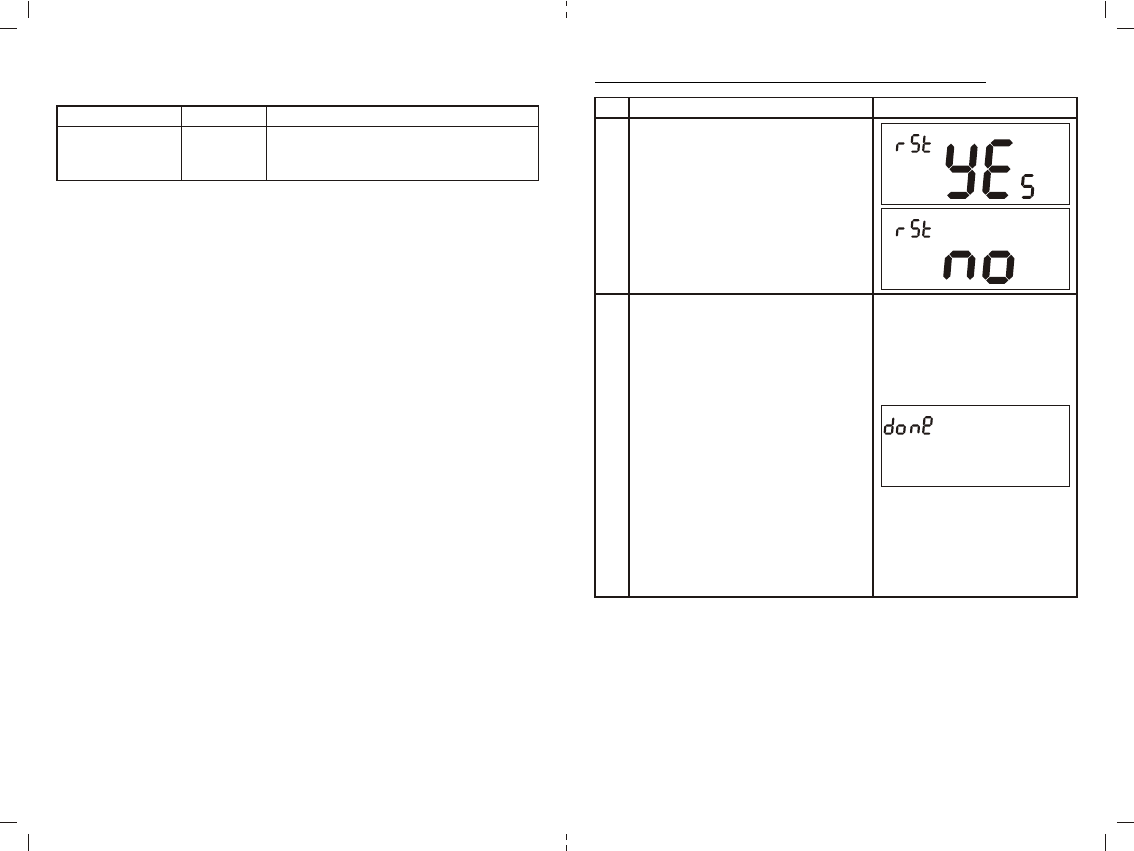
Reset ZTS-110 to Factory Default Settings
Example for sensor temperature calibration:
o o
reading temperature (77 F) + (-2 F)
If using decimal input
Parameter no. = 13
Parameter value = -2
If using hexadecimal input
Parameter no. = 0D
Parameter value = FE ( Size >= 1 byte)
o o
Display temperature = sensor reading value + offset value = 77 - 2 F = 75 F
Parameter value rangeParameter No.
Functions
o o
-2 (0xFE) = -2 F (-1.0 C)
13 (0x0D)
Sensor temperature
calibration
LCD indicationStep Procedure / Description
Press and hold "Fan" + "Mode" keys for
2 seconds to entry the reset mode.
Press Up/Down key to toggle Yes/No
selection.
1
Press "Prog" key once to confirm the action.
=> It will perform the reset if select "Yes" or
=> It will back to home page if select "No".
LCD display done after reset to factory
default settings.
The following data will be reset to default:
1. Clock : 12:00am
2. Day: Mon
3. Temperature scale: F
4. Swing : 2F
5. Diff: 2F
6. Pre-defined schedule
7. Operation mode: OFF
8. Default Heat override set point
9. Default Cool override set point
10.Filter counter cleared
11.Delete from network
12. All configuration parameters value
2
33 34
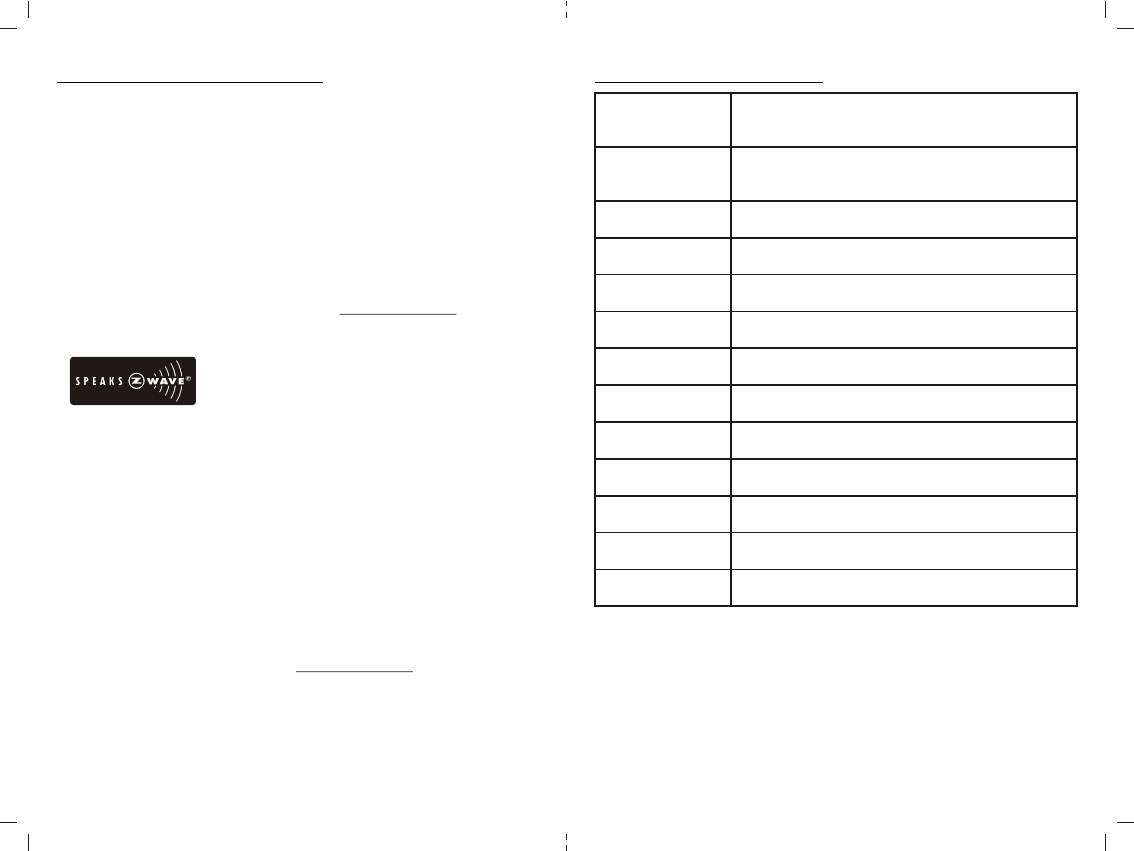
Frequently Asked Questions
Q Why won't my ZTS-110 work with the Z-Wave devices I purchased from another
country?
A Due to different countries regulations Z-Wave products from different regions are set
to different frequencies. Before purchasing new devices make sure you have
checked to see that the device is compatible in your region.
Q Do I need an electrician to install ZTS-110 in my house?
A We recommend that you acquire the services of a qualified technician to install this
product.
Q How do I know which product is compatible to my ZTS-110?
A ZTS-110 should work with any Z-Wave controller or gateway that has control
capability for "Thermostat" devices. You can check either the specifications in the
manual of your ZTS-110 or also check
roducts also come with the
Z-Wave logo.
Q Can I use 2 or more ZTS-110 in my house? What is the max. units if yes?
A Yes and it is very depends on the capability of gateway / controller. For example,
gateway can supports up to 8, 16 or 32 ZTS-110 in a network.
Q Where can I keep up to date with the latest Z-Wave products for my house?
A You can keep up to date by visitin website where we will
have information and ideas for using Z-Wave technology.
online at www.remotec.com.hk for a full list of
products that can be used with your ZTS-110. All Z-Wave p
Q What is the recommended battery type for ZTS-110 and what is estimated
batteries service life?
A We recommend using alkaline batteries for ZTS-110.
Batteries service life is very depend on the number of usage per day. Normally,
batteries service life is around 1 year while operated in FLiRS mode.
If you are using battery and somehow it is in Z-Wave Always Listening Mode, or if
you are using battery as back up, and the AC power is down, the battery will drain
very fast, battery will only survive 3-5 days.
g the www.remotec.com.hk
35 36
Technical Specifications
Model no.
BW8031US (ZTS-110US)
BW8031AU (ZTS-110AU)
BW8031EU (ZTS-110EU)
RF frequency
908.4MHz (US) (ZTS-110US)
921.4MHz (AU) (ZTS-110AU)
868.4MHz (EU) (ZTS-110EU)
RF operating
distance Up to 100ft outdoor line of sight, in unobstructed environment
Z-Wave
association group
Supports 3 association groups, max. 5 nodes ID can be
assigned to these association groups.
LCD TN type with white backlight
VA=66.5mmx28.5mm
Powered by Dry battery AA x 4pcs or
24 VAC +/- 20% 50/60Hz
Relay contact Voltage: 24 VAC 50/60 Hz
Current: 1A Max. (inductive)
Temperature
measurable range
o o
32 - 99 F / 0 - 40 C
Temperature display
resolution
o o
0.5 F / 0.1 C
Temperature Setting
range
o o
41 - 99 F / 5 - 37 C
Temperature
o o
Operating: 32 - 122 F / 0 - 50 C
o o
Storage: 23 - 140 F / -5 - 60 C
Dimension (L x H x T) 145mm x 100mm x 25mm
Weight 170g (Batteries excluded)
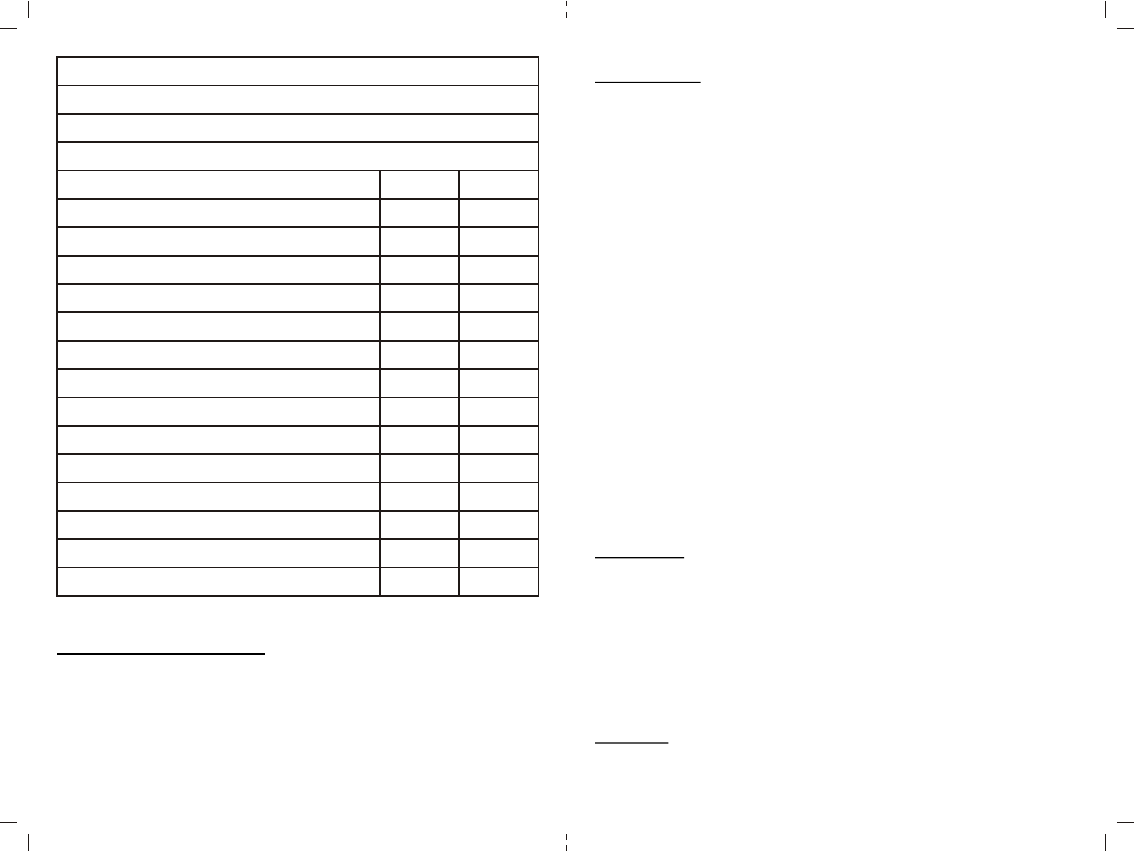
Checking Accessories
After opening the cover of the packaging box, check that the following accessories
are included.
- ZTS-110: Z-Thermostat
- Screw + Wall Anchor x 4pcs
- RC/RH jumper wire x 1pc
- User Manual
Z-Wave device type
Basic Device Class: Routing_Slave
Generic Device Class: Thermostat
Specific Device Class: Thermostat general v2
Z-Wave Command Class Controlled Supported
COMMAND_CLASS_THERMOSTAT_FAN_MODE NO YES
COMMAND_CLASS_THERMOSTAT_FAN_STATE NO YES
COMMAND_CLASS_THERMOSTAT_MODE NO YES
COMMAND_CLASS_THERMOSTAT_SETPOINT NO YES
COMMAND_CLASS_THERMOSTAT_OPERATING_STATE NO YES
COMMAND_CLASS_THERMOSTAT_SETBACK NO YES
COMMAND_CLASS_SENSOR_MULTILEVEL NO YES
COMMAND_CLASS_CLOCK NO YES
COMMAND_CLASS_BATTERY NO YES
COMMAND_CLASS_BASIC YES YES
COMMAND_CLASS_VERSION NO YES
COMMAND_CLASS_MANUFACTURER_SPECIFIC NO YES
COMMAND_CLASS_ASSOCIATION NO YES
COMMAND_CLASS_CONFIGURATION NO YES
37 38
FCC Notice
This device complies with Part 15 of the FCC rules. Operation is subject to the
following two conditions:
(1) this device may not cause harmful interference, and
(2) this device must accept any interference received, including interference that
may cause undesired operation.
NOTE:
This equipment has been tested and found to comply with the limits for a Class B
digital device, pursuant to Part 15 of the FCC Rules. These limits are designed to
provide reasonable protection against harmful interference in a residential
installation. This equipment generates, uses and can radiate radio frequency
energy and, if not installed and used in accordance with the instructions, may cause
harmful interference to radio communications. However, there is no guarantee that
interference will not occur in a particular installation. If this equipment does cause
harmful interference to radio or television reception, which can be determined by
turning the equipment off and on, the user is encouraged to try to correct the
interference by one or more of the following measures:
- Reorient or relocate the receiving antenna.
- Increase the separation between the equipment and receiver.
- Connect the equipment into an outlet on a circuit different from that to which the
receiver is connected.
- Consult the dealer or an experienced radio/TV technician for help.
Notice : Changes or modifications to this unit not expressly approved by the party
responsible for compliance could void the user authority to operate the equipment.
Warnings
- Do not modify the unit in any way.
- Risk of fire.
- Risk of electrical shock.
- Risk of burns.
- Do not dispose of electrical appliances and unsorted municipal waste, use
separate collection facilities. Contact your local government for information
regarding the collection systems available.
- There is no user serviceable parts in this unit.
Caution
- Risk of explosion if battery is replaced by an incorrect type.
- Dispose of used batteries according to the instructions.